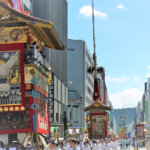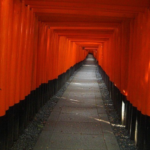Kyoto city is rainy season in June and July. Kyoto city is always busy with tourists. However, Kyoto has few tourists during the rainy season (late June and early July) and cold season(February).
In the rainy season, it is raining and I can not go sightseeing. (However, there will be more people when Gion Festival starts …)
In this time I will introduce “Fushimi Inari Shrine” which is very popular among foreign tourists.
The Fushimi Inari Shrine is actually quite wide, and the number of shrines built across the Inari Mountains is tremendous. The glamorous ‘tower gate’, ‘main hall’, and ‘Senbon Torii’ that you often see and image in the news etc. are just a small part of the bustling Fushimi Inari Shrine at the foot of Inari Mountains.
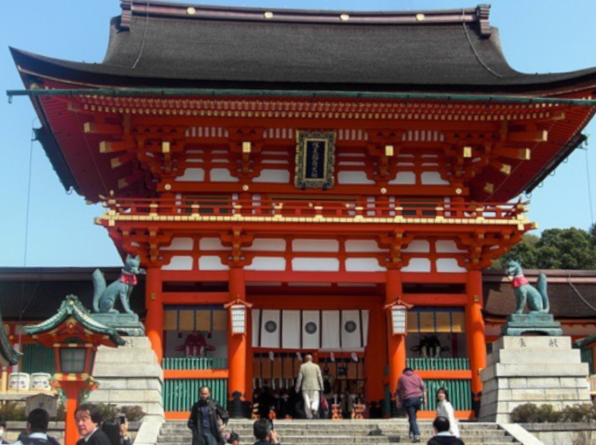
However, the real Fushimi Inari Shrine is beyond that.
A huge Inari Mountain that spreads beyond the back of the ‘Senbon Torii’ and the tip of the ‘Okunoin’. A tour of Mt. Inari 4 km per lap.
When you step through it, you should no longer be yours when you enter the Fushimi Inari entrance. The image of Fushimi Inari Shrine that you had until then must have changed greatly.
From light tourists to deep Inari believers, it is “Fushimi Inari Shrine” which has always been very popular.
Here, I will introduce Fushimi Inari Shrine with photos on multiple occasions. Please visit the area to experience the great power of Fushimi Inari Shrine.
- Introduction
- Outline of Fushimi Inari Shirine
- JR ‘Inari station’ and KEIHAN ‘Fushimi Inari staion’
- The first torii gate ‘Ichi no Torii’
- The first Torii gate ‘Ichino Torii’ and vermilion
- Reikon shrine / Fujio shrine / kumano shrine
- ‘Omotesando’ and ‘Sansyuden’
- The tower gate ‘Romon’
- Left and right ministers in tower gate
- Outer hall ‘gai-haiden’
- Inner hall ‘nai-haiden’
- main shrine ‘hon-den’
- Temporary shrine ‘Gonden’
- Old House Kada-no-azumamaro
- Azumamaro shrine
- Your good actions can keep Kyoto beautiful.
Introduction
It is said that Japan has “eight million gods (Yaoyorozu gods)”, and there are about 90,000 large and small “shrines” that worship the gods. About 30,000 of them are said to be “Inari Shrine”. The Inari Shrine has spread to many areas of Japan.
Fushimi Inari Shrine Shrine is the main shrine of Inari Shrine that has reached Japan’s wide area.
Although Fushimi Inari Shrine is known to be a god of agriculture and industry commerce such as five grains rich, prosperous business and industrial prosperity, it is said that there are benefits for home safety, traffic safety and performing arts.
Fushimi Inari Shrine began as a shrine worshiper of “Mr. Hata” who ruled this area before Heian’s capital transition, but since Heian era, it has become a very popular shrine from the emperor to nobles and common people. It is also known that there are a large number of foreign tourists including the first customer even now.
Why did this Fushimi Inari Shrine become a popular shrine? Why did many companies start to stand up? What is the relationship between the many worshiped gods being beaten?
In order to solve these questions, I would like to go around the mountains of Fushimi Inari Shrine, which has rare scenery in the world.
Outline of Fushimi Inari Shirine
Fushimi Inari Shrine is the main mountain of Inari Shrine in ‘Fukakusa’, Fushimi-ku, Kyoto, as described above.
Inari Okami, commonly known as “Inari-san”, sits at the foot of Inari Mountain at the southern end of the 36 Higashiyama peaks in Kyoto. Inari Mountain has long been described as “Inari Mountain”. From ancient times, perennial areas were wetlands, but mainly by the lands of the great families, rice cultivation has become popular. Then, it is said that Inaneri (likely) turned to “Inari” and the letters “Inari” were addressed. In other words, the roots of Inari Shrine are shrines dedicated to the indigenous gods and agricultural gods of the powerful men who ruled the land.
The affluent family is Mr. Tatsumi, Mr. Kamo, Mr. Mr. Hata, and it varies depending on the literature, but any company can be seen in Inari Mountain.
We introduce the beginning of Fushimi Inari Shrine. In general, the three gods of Inari, including “Uka no mitama no ookami”, descended near the top of Mt. Inari. It is said that Mr. Hata built the company there.
After that, the main shrine has been transitioned to the current position, but each of the three will become to be believed as a “Shinsekichi”.
Inari believers aim at the top of the Inari mountain at 233m elevation to get the benefit. It is called “Oyama tour” to go around this shrine of Inari Mountain. For now, trails, mountain climbing, in the old days there was a little foothold, so it may be like “studying”.
I would like to walk from the JR ‘Inari’ Station as a starting point this time in the footsteps of the “Oyama Tour” which has been conducted since the Heian period.
The figure below is a guide map of the whole Inari mountain. The area centered on the “main hall” in the lower part of the figure is the “Fushimi Inari Shrine” in a narrow sense. There is also a related “shrine” that is a representative shrine.
There is a subsidiary company or company of “Fushimi Inari Shrine”, which will be mentioned later, but there are also completely unrelated companies.
Inari Mountain is also a theme park for these shrines.

Let’s start now.
In the first installment, I will introduce the area around the entrance of Fushimi Inari Shrine.
The route is around the main shrine at Fushimi Inari Shrine by getting off the nearest JR ‘Inari’ Station and entering from the ‘first torii gate’.
JR ‘Inari station’ and KEIHAN ‘Fushimi Inari staion’
To access Fushimi Inari by train, use JR ‘Inari Station’ or KEIHAN ‘Fushimi Inari Station’. If coming from Kyoto Station, take the JR Nara Line and arrive at 2 stops from Kyoto Station. One-way 5 minutes, fare is 140 yen.
JR ‘Inari Station’. It is located in front of ‘Omotesando’ and is the ‘first torii gate’ as you cross the street.
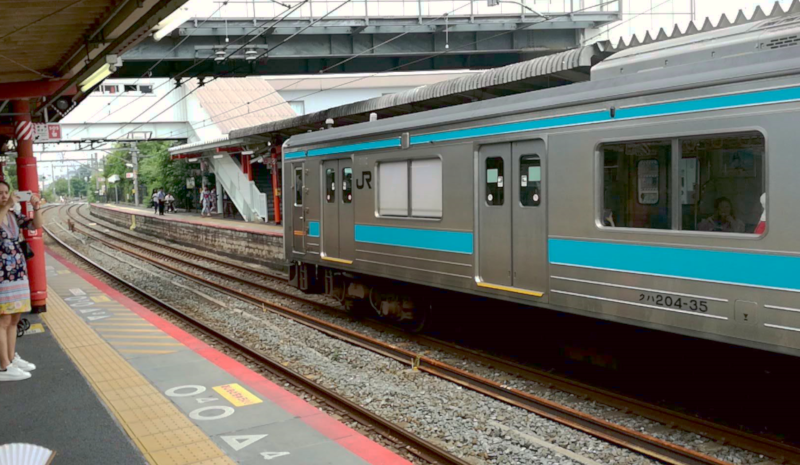
There is a convenience store next to the station. It ’s a good idea to buy food and drink here. The food and beverages sold in Fushimi Inari Shrine are too expensive.

The photo below shows KEIHAN ‘Fushimi Inari station’.
This station is located on the west side of another approach, Shinkoudo. If you are coming from Osaka, take the limited express train from Kyobashi to Tambabashi, change from Tambabashi and arrive at 4 stations.

The entrance to Fushimi Inari Shrine is not one, but if you use Keihan Fushimi Inari Station, you will go to the north side, Shinkodou (Kitasando).
If you come by car, there is a parking entrance just to the right (south) of The first Torii gate. However, Fushimi Kaido (Honmachi Dori) is a one-way street from south to north.
If you are coming from the north, drive down the ‘Shidan-Kaido’ or ‘Route 24’, go east on the ‘Daiichi-gundo’ in front of ‘Ryukoku University’, and go north on ‘Honmachi-dori’ Should.

The first torii gate ‘Ichi no Torii’
When you get off JR Inari Station, you will see a large vermilion torii in front. “Ichi no Torii” is the main entrance of Fushimi Inari Shrine. Facing Fushimi Kaido (Honmachi Dori). “Ichi no Torii” means the first gate of shrine.
As mentioned above, going around Mt. Inari, where Fushimi Inari Shrine is located, is called “mountain tour”, but this is the starting point for “mountain tour”.
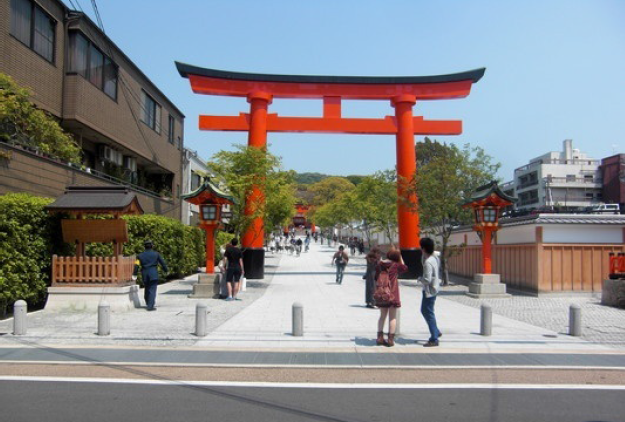
This is a picture of June 2013, six years ago. At that time, there were not many foreign tourists.

And it is the first torii gate in July 2019. I thought there were few people during the rainy season, but there were already many people at 9:00 am.
Recently, there are many Asian tourists, and the number of Japanese has decreased. Over the past few years, the number of visitors has changed dramatically.
Since then, 2013 photos and 2019 photos have been mixed. For the places judged to have little aging, we use good 2013 photos.
The first Torii gate ‘Ichino Torii’ and vermilion
The photo below shows the torii from the approach.
The torii gates at Inari Shrine and Fushimi Inari Shrine in Japan are called ‘Inari Torii’. The bottom of the pillar is rolled up with a black painted board.
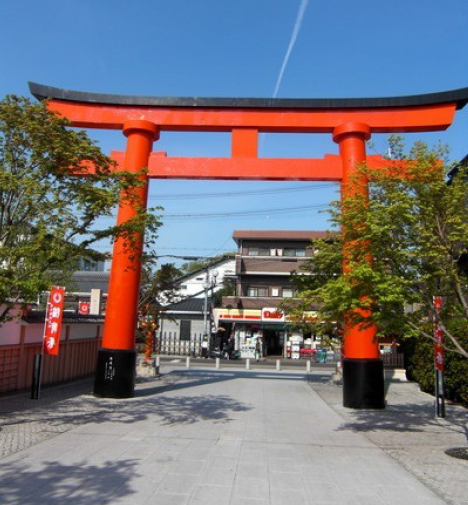
Most of Fushimi Inari’s torii is dyed in the symbol color vermilion.
Vermilion imagines “life” and “dynamic”. This color is also said to be wicked and call for happiness.
Most of the torii gates are made of “cedar”, and there are many companies in Fushimi Inari that have engraved “cedar” on the sacred body.
The surface of the torii is coated with a lot of oil called “Komyotan” dissolved in oil to prevent insects and corrosion. Once produced and devoted, the torii will last for 20 years and will continue to sit on Mt.Inari as proof of people’s faith.
Reikon shrine / Fujio shrine / kumano shrine
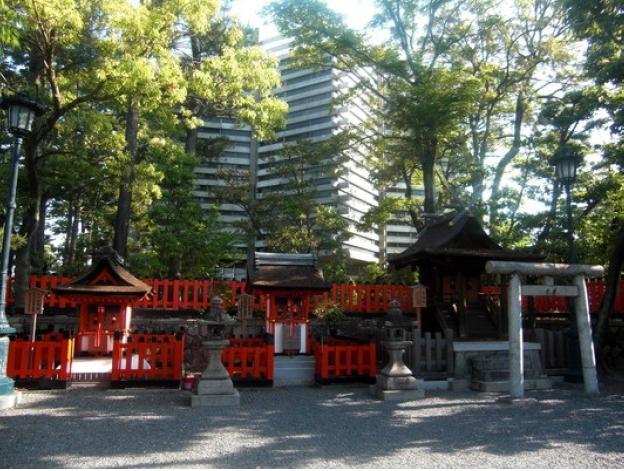
Fushimi Inari shrine has many shrines of various sizes.
There is also a shrine between ‘Omotesando’ and ‘Romon’, and from the right are “Reikon-shrine”, “Fujio-shrine” and “Kumano-shrine”.
“Fujio-shrine” and “Kumano-shrine” are said to have been enshrined here before Fushimi Inari shrine.
The building at the back is the “Ritual Hall” of the Fushimi Inari shrine, which has the shape of an eight-pointed star.
‘Omotesando’ and ‘Sansyuden’
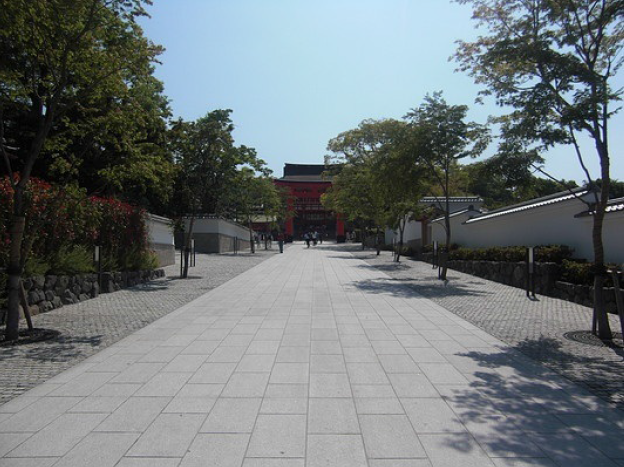
There is a stone pavement from the first Torii gate to the second Torii gate. The torii gate and the tower gate ‘Romon’ are visible in the back.
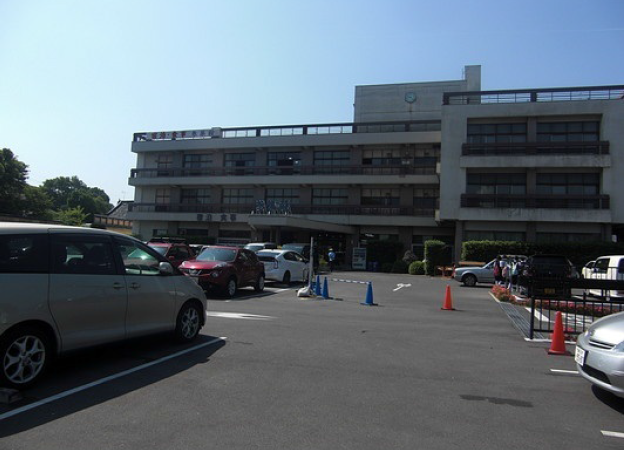
The top photo is the Sansyuden. It’s accommodation at Fushimi Inari Shrine. There are other events, rest areas and restaurants.
The tower gate ‘Romon’

If you follow ‘Omotesando’, you will see the main tower gate of Fushimi Inari shrine.
This tower gate is a double-layered main building with a contrasting vermilion roof and a contrasting vermilion.
This tower gate was built in 1589 by Hideyoshi Toyotomi.
Hideyoshi, who achieved the unification of the world, set up Fushimi Castle in the Momoyama area, south of Fushimi Inari shrine, and the castle town flourished.
As Fushimi Castle and Fushimi Inari shrine are close to each other, Hideyoshi deepened his faith in Inari and prayed for his mother’s great healing.
As a result of the prayer, his mother recovered from the illness, and Hideyoshi donated a full restoration of the shrine and other shrines. Now the gate we see was erected at that time.
Later, it was restored in 1974 and 2010.
A pair of sculptures in front of the tower gate contains a jewel and a key.
Left and right ministers in tower gate
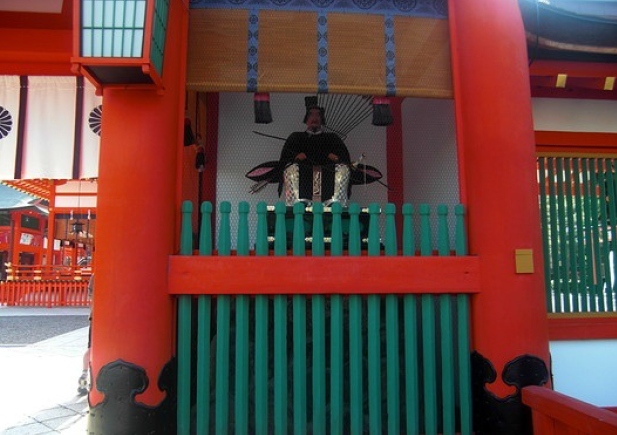
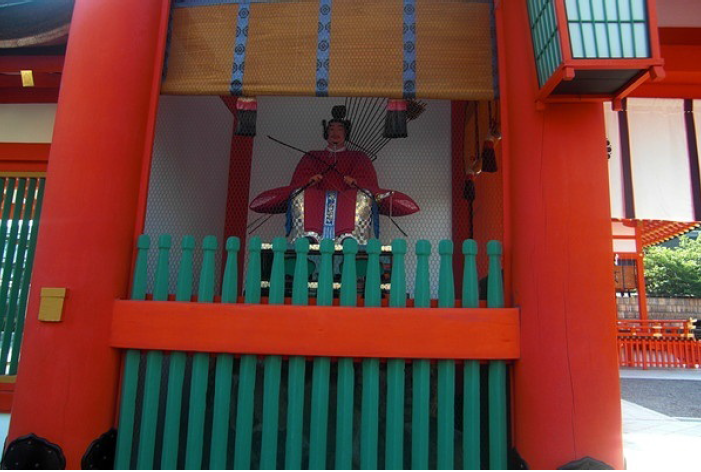
The ‘Ni-oh’ is greeted at the main gate of the temple, but at the shrine there are two ‘A-Un’ ministers.
On the right side is an ‘A’-shaped left minister with an open mouth, and on the left side is a ‘Un’-shaped right minister with a closed mouth.
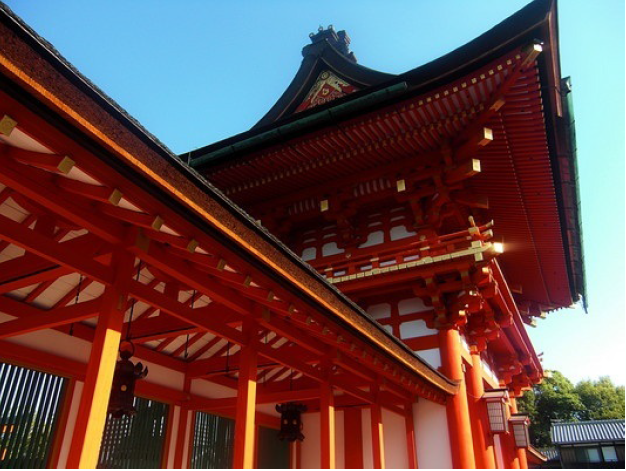
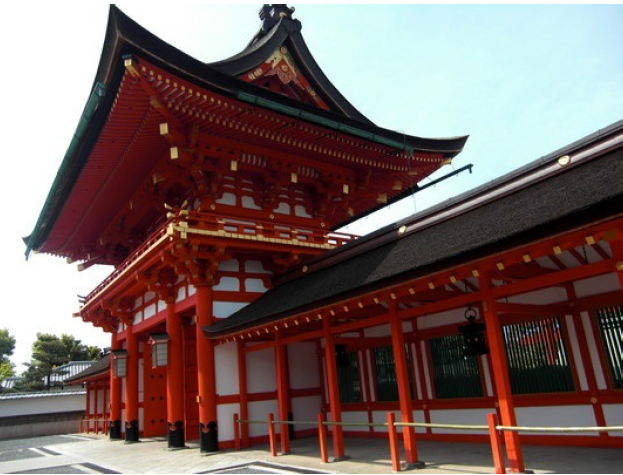
This is the gate from the inside of the precinct. The powerful vermilion gate that incorporates the Momoyama style is one of the best gates in Kyoto.
Outer hall ‘gai-haiden’
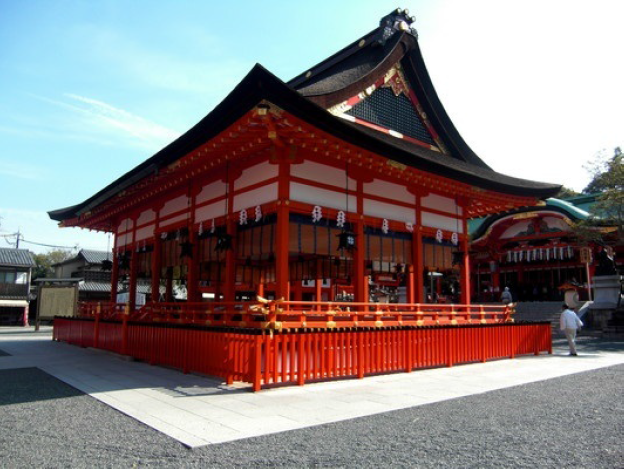
The ‘gai-haiden’ is visible in front of the gate.
Fushimi Inari shrine has two main halls ‘haiden’, the inner and outer halls.
A ‘haiden’ means a place to pray to God of Shinto.

The inner hall ‘nai-haihiden’ is used for general visits, and the outer hall ‘gai-haiden’ is used at the Setsubun festival in February, from which beans are thrown.
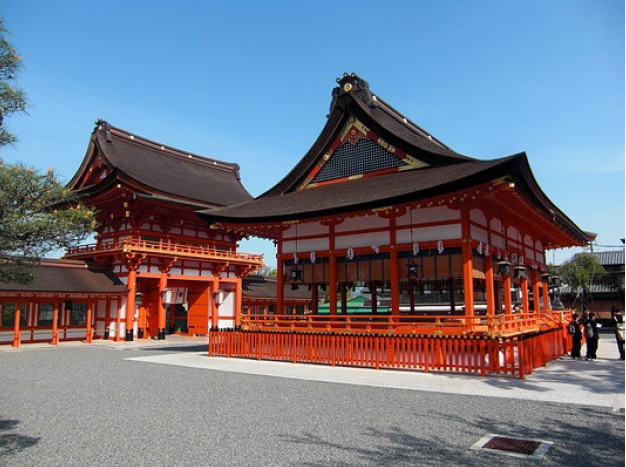
These are the tower gate ‘Romon’ and outer hall ‘gai-haiden’. The outer hall was also built by Hideyoshi at the same time as tower gate ‘Romon’.
Inner hall ‘nai-haiden’

The inner hall ‘nai-haiden’ was built in 1694.
A large vermilion decoration of “Karahafu” was featured, and it was attached to the inner shrine in 1961. A similar “Karahafu” has been incorporated into the ‘Gokonomiya Shrine’ in Momoyama Ohtesuji in the same Fushimi Ward. This is the reason why Hideyoshi’s favorite karahafu is called ‘Momoyama’ style.
A pair of foxes are placed on both sides of the stone steps leading to the inner hall ‘nai-haiden’.
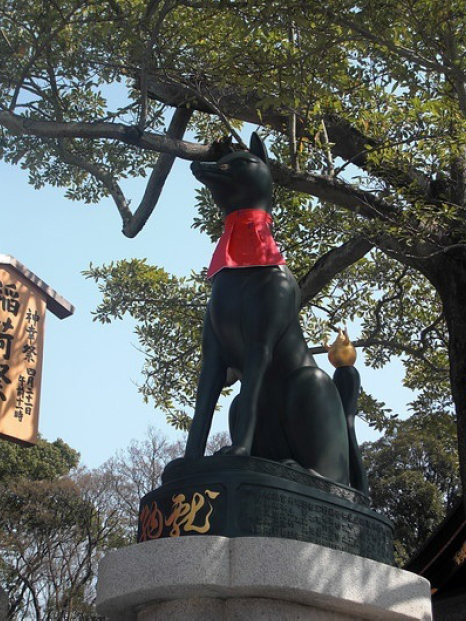
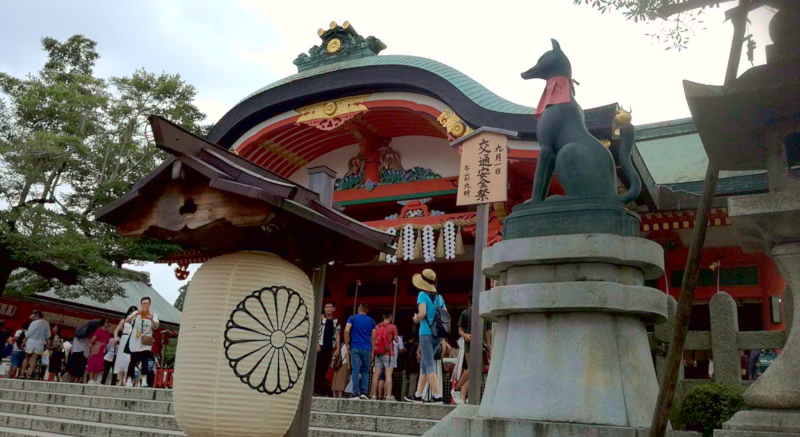
There is a chrysanthemum crest. There may be a connection with the Emperor’s family. There will be many shrines with chrysanthemums in the Inari shrines. For example, “Shiragiku ohkami” is another name for the main priest deity here, and is reminiscent of its connection with Ise Taisha shrine.
main shrine ‘hon-den’
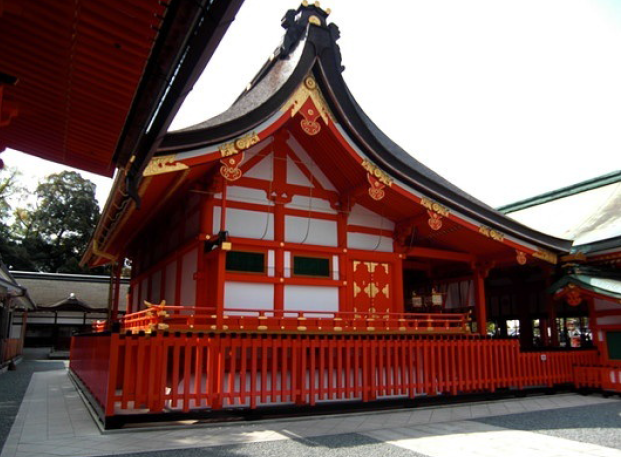
The main shrine was designated as an important cultural property that was reconstructed in 1499 after being burned down by the Onin War.
The main shrine is lined with five shrines to worship the five gods of the festival.
As a result, the shrine is wide and the roof is not even on the entire surface and the back, and the front is longer than the back.
There are 3 pillars of ‘kami(Upper)-shrine’, ‘Naka(Middle’-shrine’, and ‘Shimo(Lower)-shrine’, and 2 pillars of Tanaka and Ohyashima. It is beaten in the following order from the left (north).
| the most north | Tanaka | Gondafu | Tanaka shrine |
| north | Satahiko | Aoki | Naka shrine |
| center | Ukanomitama | Shiragiku | Shimo shrine |
| south | Ohmiyame | Suehiro | Kami shrine |
| the most south | Shi | Ohyashima | Ohyashima shrine |
The rightmost column in the table is another name for God. The shrines where the gods were enshrined are scattered around Mt.Inari. A trip around these footsteps of God becomes a mountain tour.
These five pillars are collectively called God of Inari. Which is not the main priest deity and is five pillar equality.
Therefore, as mentioned above, the shrine is equally divided into five.
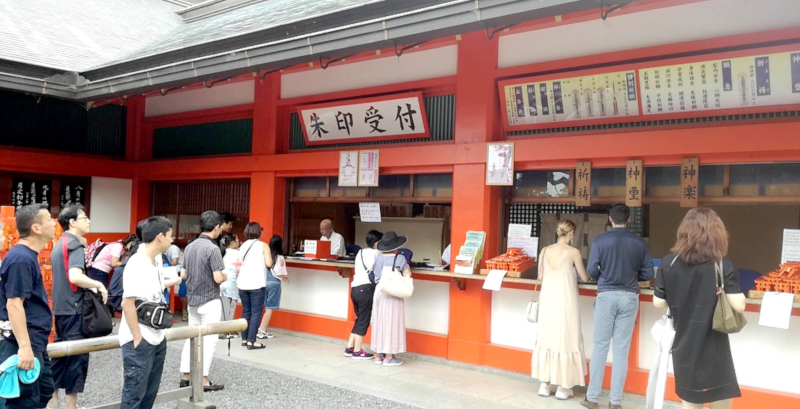
A red stamp and amulet are also sold next to the main shrine.
Temporary shrine ‘Gonden’
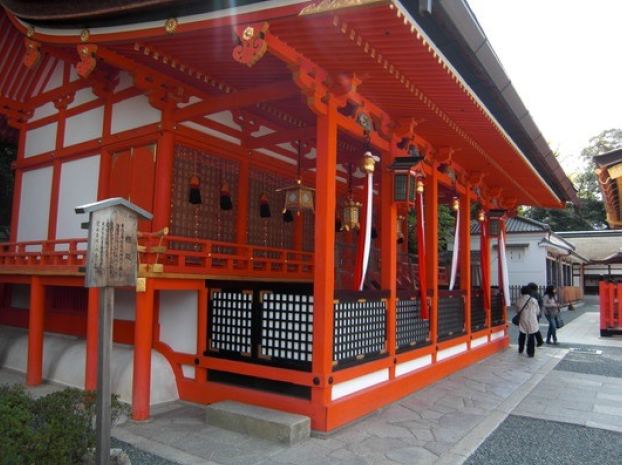
It is the same five shrines as the main shrine. It is used as a temporary palace when renovating the main shrine.
Old House Kada-no-azumamaro
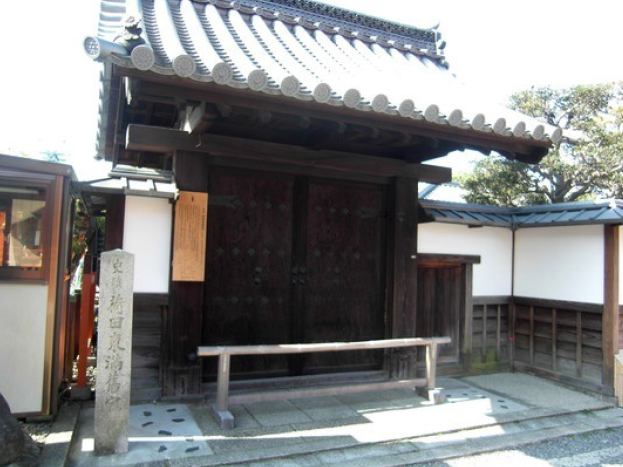
There is “Old House Kada-no-azumamaro” in the south of the outer hall ‘gai-haiden’.
Kada-no-azumamaro (1669-1736) was born in the Fushimi Inari priest Kada family. However, he did not inherit the priesthood and was devoted to classical Japanese studies. He made achievements with ‘Shinen Kamo’, ‘NorinagaMotoori’ and ‘Atsutane Hirata’. The old house is now a nationally designated historic site as “Kada-no-azumamaro Old House”.
In addition, near the top of Mt. Inari, between the second and third foothills, there is the Kada Shrine that enshrines the great god of the Kada family.
Azumamaro shrine
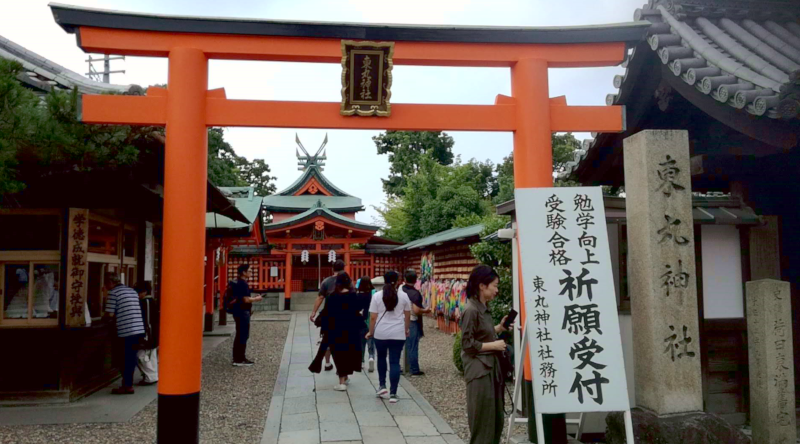
Azumamaro shrine is adjacent to “Old House Kadanoazumamaro”.
Azumamaro shrine is built in 1883 by Gu-ji and others at Fushimi Inari Shrine.
Many people who wish to improve their academics and pass the exam will come to visit Azumamaro shrine.
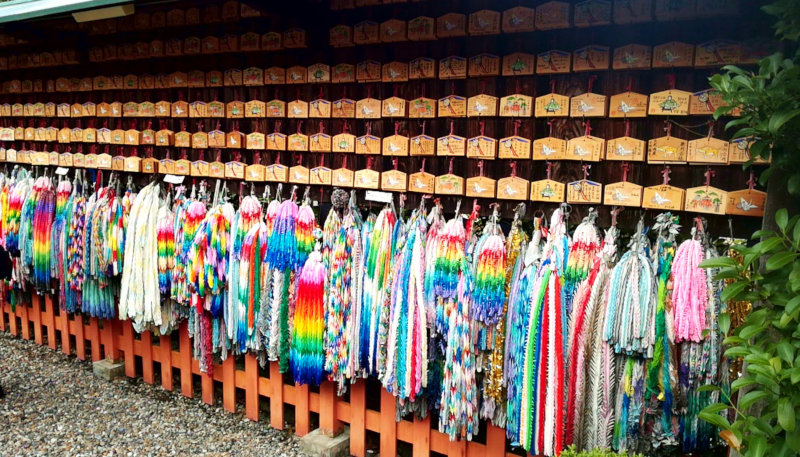
These are ema and thousand cranes arranged regularly without gaps. Surely they will benefit. I felt a strong feeling of prayer.
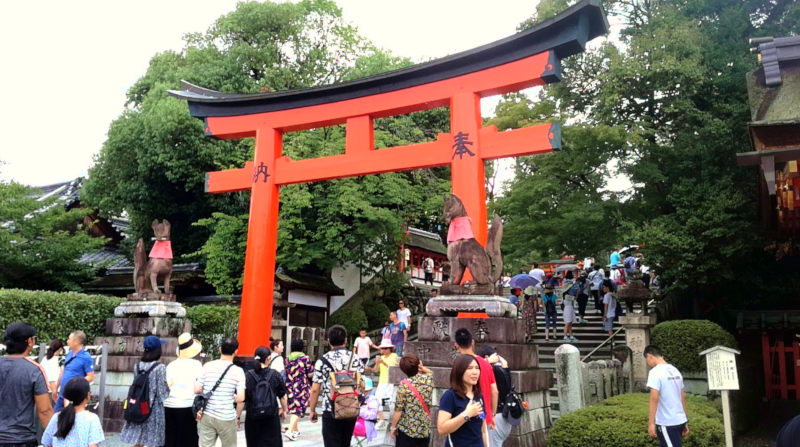
The above is the precincts of “Fushimi Inari Shrine”.
If you pass through the torii behind the main shrine, you will escape from the precincts and continue in the direction of ‘Senbon Torii’. It’s means thousand torii gate.
There are people who visit only the main shrine and return, but many tourists return to see the later Senbon Torii.
This is the end of the first introduction. It will continue to the next.
Your good actions can keep Kyoto beautiful.
Recently, many foreign tourists have visited Kyoto. Kyoto citizens are in trouble because of their poor manners.
Japanese tourist spots are not just for you. If you like Kyoto , please keep it clean and follow Japanese manners so that many people can have a good time in Kyoto.

